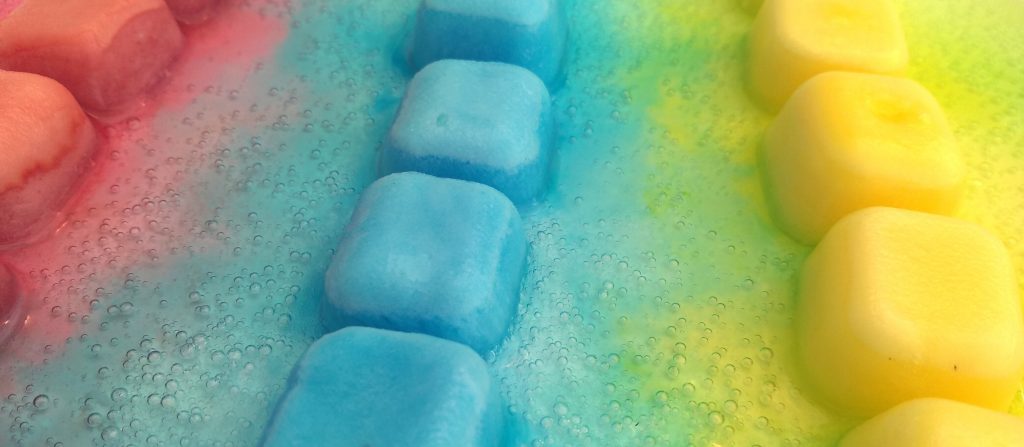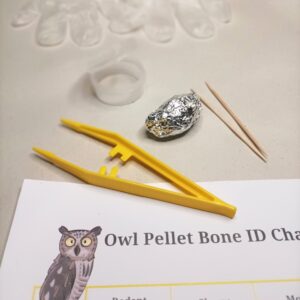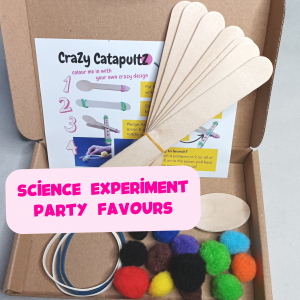Make fizzy ice cubes and rainbows of colours in our latest science experiment! You need very little equipment for this ice-cool fizzy experiment ideal for toddlers – baking soda, ice cube tray, water, colouring & vinegar. This is a practical and fun way to observe colour mixing, chemical reactions and change of state.
For the fizzy ice cube science experiment, you first need to make the special ice cubes. These are water with added colours and baking soda (also known as sodium bicarbonate). Then, once they are frozen, you pop them out onto a tray for a fizzing fun science experiment with your budding scientist.
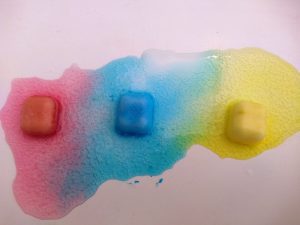
Rainbows of colours. You can see the secondary colours forming as the primary colours mix.
Fizzy ice cube science experiment materials:
- Ice cube tray
- Water
- Baking soda (sodium bicarbonate)
- Food colouring
- Jug or bowl for mixing
- Stirrers – we used cocktail sticks
- Clear vinegar
- Pipette (optional)


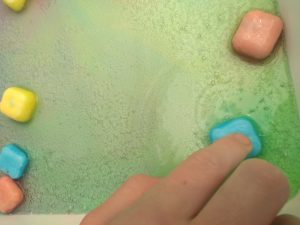
Method
- Add water to the bowl and stir in a large spoonful of baking soda. We used about 1 tablespoon for 100ml of water which created a nice fizz, but the quantities aren’t critical.
- Pour your baking soda water into the ice cube trays – don’t over fill otherwise the colours (next step) will get mixed up.
- Add colouring of your choice to the cubes and use a cocktail stick to gently mix in. We chose the primary colours, red, yellow & blue so we can create the secondary colours in the melting phase.
- Place in the freezer until frozen.
- Once frozen, pop the ice cubes out on a tray or large plate or directly on the ground outside.
- To melt the ice cubes and see the fizzy reaction, you squirt vinegar onto them – you can do this directly from the bottle or use a pipette.
- Enjoy the fizz and colours. When you have finished you can wash the waste down the sink.
- Please share your pictures with us on Facebook.
The science bit!
Physical changes – gas, liquids & solids.
Changes of state are reversible physical changes, and in our fizzy ice cube science experiment, the water changes from solid to liquid as it melts. We can reverse this by putting the water back in the freezer. The chemical make-up of the water has not changed.
Chemical Changes – Why do the ice cubes fizz?
A chemical change is when something new is created during a reaction, and the chemical make up of the original materials becomes altered. In our fizzy ice cube science experiment, the fizz is due to a chemical reaction between the acid (vinegar – acetic acid) and the alkali (sodium bicarbonate). The actual bubbles are carbon dioxide (CO2) gas produced in the reaction. The vinegar and sodium bicarbonate change during the reaction to create new compounds – CO2 gas, water and sodium acetate.
Want more easy science?
If you try these activities at home you do so at your own risk.
Grab one of our science kits so you don’t have to gather all the materials needed, check them out here.
Looking for more easy science ideas? Well head on over to our blog to find out other cool experiments such as Glowing Fluorescent Liquid or the Super Easy 6 – a free download with 6 super-easy experiments to try at home!
Happy science-ing
Ruth
Chief Scientist at Devon Science


